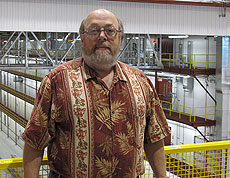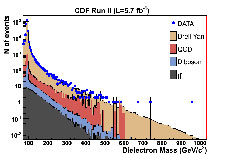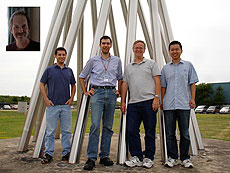|
Thursday, Sept. 1
- Breakfast: Apple sticks
- Santa Fe black bean soup
- Steak tacos
- Chicken Wellington
- Chimichangas
- Baked ham & Swiss on a ciabatta roll
- Assorted sliced pizza
- Smart cuisine: Crispy fried-chicken salad
Wilson Hall Cafe Menu
|
|
Friday, Sept. 2
Dinner
Closed
Wednesday, Sept. 7
Lunch
- Ham & gruyere crepes
- Cabbage salad
- Strawberry almond cream tart
Chez Leon Menu
Call x3524 to make your reservation. |
|
Bill Miller takes over orchestrating NOvA assembly
 |
| Bill Miller, assembly manager for installing the NOvA far detector, in front of the assembly hall in Ash River, Minn.
|
In particle physics, most people dream of the day when their experiment is finally up and running.
Bill Miller would much rather be in the thick of a giant construction project.
“This is the exciting part of the experiment - all the design and the R&D work,” said Miller, who was recently hired as the NOvA assembly manager for detector installation at the NOvA Far Detector Building in Ash River, Minnesota.
Miller, who left a position as lab supervisor at the Soudan Underground Lab, has more than 25 years of experience installing underground detectors for the University of Minnesota. He oversaw construction and installation of the MINOS far detector, one of two machines scientists use to understand whether a ghostly particle called a neutrino changes as it travels, and has been involved in the NOvA project since it began in 2002. He spent a lot of time at both Fermilab and Argonne to help construct the NOvA near detector, which is housed at Fermilab.
Scientists will use the NOvA detectors to analyze the mysterious behavior of neutrinos, specifically to see if muon neutrinos change into electron neutrinos. This information could help scientists understand whether neutrinos contributed to the imbalance between matter and antimatter in the universe.
The NOvA experiment’s construction is supported by a cooperative research agreement between the U.S. Department of Energy and the University of Minnesota. The NOvA collaboration achieved beneficial occupancy of the assembly building in April. Now, a crew of seven is working on installing the fixtures necessary for Miller and his team to start assembling the detector.
In his new role, Miller is orchestrating the acquisition and installation of the separate elements necessary for the project’s assembly. Meanwhile, the University of Minnesota is looking for someone to take over Miller’s old role as lab supervisor at the Soudan Underground Mine. The posting for that position is available here.
—Rhianna Wisniewski
|
Pause for a Monet: Water lilies
 |
|
The sun sets over the water lily field in the Main Ring on Saturday, Aug. 27. Photo: Michael McGee, AD |
|
Did the LHC just debunk superstring theory?
From PCMag.com, Aug. 30, 2011
New data from Europe's Large Hadron Collider may signal the end of one of the most popular theories in physics, superstring theory. If the conclusions are true, scientists would need a new leading candidate for the "theory of everything."
The LHC actually hasn't debunked superstring theory directly. The theory maintains that everything in the universe is actually made up of extremely small vibrating strings. The strings, if they exist, would need to be much smaller than even the smallest particles that are known, and it's impossible for current science to probe such tiny scales.
However, the theory requires some effects on a scale that can be measured, one of those effects being "supersymmetry."
Read more
|
Controlling for the “look-elsewhere effect”
From Physics, Aug. 30, 2011
One of the primary purposes of the Large Hadron Collider (LHC) is to search for the unexpected. Usually this means looking for a “bump” in the data—an excess of events over a known background level. Such an excess could be due to new physics. However, experimentalists must account for the fact that if they look at enough areas of parameter space, they are certain to see statistical fluctuations. To control for this “look-elsewhere effect,” the data must be normalized for the number of places searched in which a fluctuation could be observed.
The Compact Muon Solenoid (CMS) collaboration at the LHC has now performed many searches for new physics, and seen very few potential bumps. But, in a paper appearing in Physical Review Letters, in which they analyze data taken in 2010, CMS reports a small excess.
Read more
|
|
No extra dimensions found
 |
| The di-electron mass distribution for the CDF data. The expected Standard Model backgrounds (Drell Yan, QCD, diboson and top-antitop)
are summed and compared with the data.
|
One question that continues to puzzle physicists is why gravity is so much weaker than the other fundamental forces (strong, electromagnetic and weak). The strength of gravity is only one hundredth of a billionth of a billionth of a billionth of a billionth of the strong interaction, or 10-38 times less.
In 1999, Lisa Randall and Raman Sundrum, physics theorists, proposed a remarkable model of extra dimensions that provides an answer to this question. In their model, they postulated the existence of an undetected spatial dimension, in addition to the four dimensions of ordinary space and time.
The strength of gravity is weakened by the presence of this extra dimension, in which only gravity can enter. The graviton, a particle that transmits the force of gravity, can have momentum in the extra dimension, which will look like mass. The interaction of gravity and the extra dimension will appear to us as a new heavy particle that physicists call a RS graviton. This graviton would transmit gravity the same way that the photon transmits electricity and magnetism or the W and Z particles transmit the weak force or the gluon transmits the strong force.
At the Tevatron, the RS gravitons would appear as heavy, unstable particles decaying into particle-antiparticle pairs. CDF physicists looked for new particles decaying into pairs of charged leptons. The advantage of studying this channel is that scientists know where to expect the background data, so any deviations from the Standard Model would be clearly evident.
Recently CDF physicist performed a generic search for di-electron and di-muon resonances indicating the presence of a graviton. A resonance would look like a spike in an otherwise smooth curve. Physicists used a data sample corresponding to 5.7 inverse femtobarns for this search. There was not an excess over the background prediction, meaning scientists did not find any measurements suggesting the presence of a graviton.
This result, combined with a previous published search in the photon-photon channel, excludes the existence of Randall-Sundrum gravitons below a mass of 1.1 TeV/c2, for an extra dimension of approximately 10-30 meters.
Learn more
—Edited by Andy Beretvas
 |
| These physicists were responsible for this analysis. From left: Michael Gold (inset), Marcelo Vogel, John Strologas, University of New Mexico;
Ray Culbertson and Tingjun Yang, Fermilab.
|
|
|